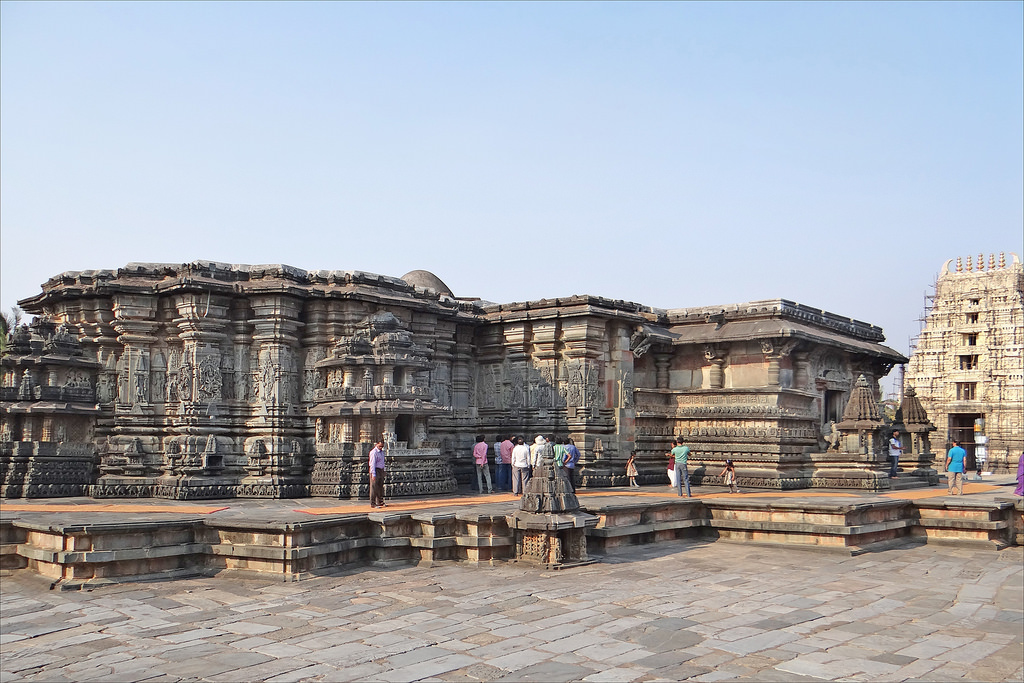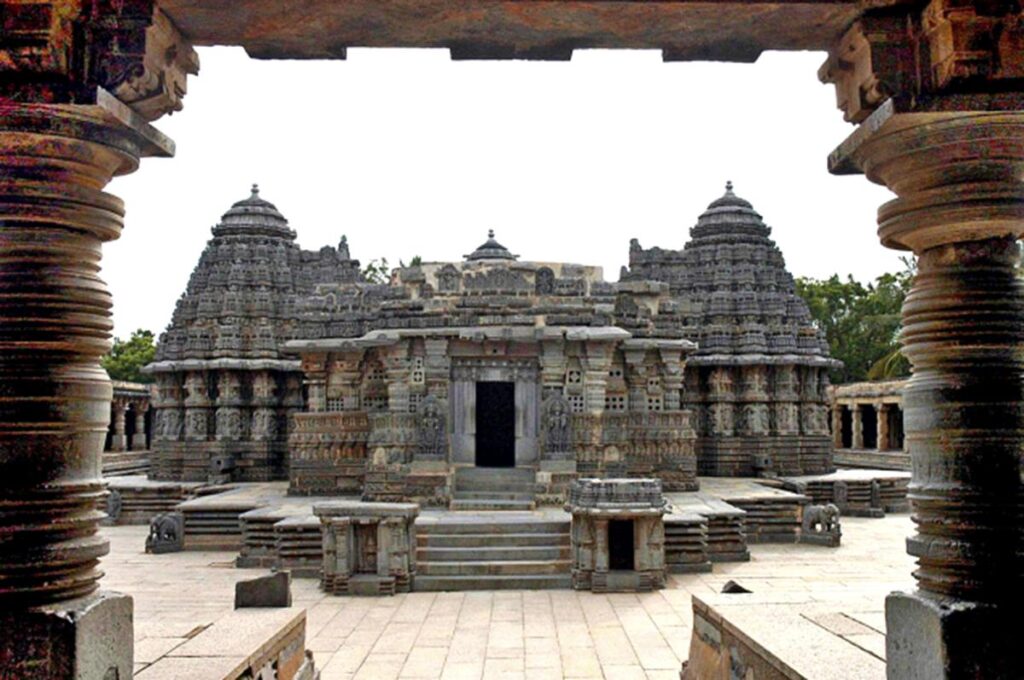“Why is the south wind delayed? Why has it not set in yet? It has been stopped by filling the nostrils of the skulls of the enemies slain in King Vishnuvardhana’s expeditions of victory on the banks of the Kaveri.”
These lines are from a colourful 12th-century inscription that records the victory of the Hoysala king Vishnuvardhana over his Chola rivals. To commemorate this momentous event, Vishnuvardhana did what many kings of his time did. He built a grand temple. Commissioned by royalty and that too by the ambitious young Vishnuvardhana, the temple in Belur was of course a statement. The Channakeshava temple, originally called the Vijaya Narayana temple, was consecrated in 1117 CE.
Built of schist, conceived on a grand scale and with novel architecture, one imagines the temple must have been a sensation.
Four years after the temple at Belur, a merchant named Ketamalla commissioned an even grander temple in the Hoysala capital of Dorasamudra (modern Halebidu). The Hoysalesvara temple incorporated many of the features that first appeared in Belur’s royal temple and also introduced many more. These temples together established a distinctive Hoysala idiom that we see in different formats over the next 150 years.

Three essential attributes of the temples stand out. The first thing most visitors to the temples remark upon is the dense ornamentation on the temple walls and interiors. The parade of life-sized animated sculptures of deities and semi-divine beings along the upper part of the walls is complemented by the fine carvings on the palm-sized sculptural bands below them. All the carvings are characterised by high relief and intense detailing. You can see the assured confidence with which sculptors explored and played with schist, as if to express its maximum potential.
Of course, the ornamentation and carving served to enhance the experience of devotees at the temple.
Similar confidence is apparent in the way that Hoysala artists experimented with different typologies and influences to build their temples. In Belur, for example, the central Indian bhumija shikhara is ubiquitous. A lofty bhumija-inspired shikhara once crowned the Belur temple (it was removed in the late 19th century). The bhumija is also prominent as a decorative motif on the temple walls and in the shikharas of the many subshrines along the stairways and around the jagati. The jagati itself has long been a standard feature of temples in western and central India. However, an innovation seen in Belur and Halebidu is that the jagati mirrors the temple’s stellate plan, thus highlighting the zigzagging geometry of the temple walls. The stellate planform itself was unusual though not entirely novel, having been used in a few Chalukya temples before. And of course, inspired by Chalukyan precedents, the temple’s walls were profusely ornamented with large figural sculptures on every indentation of the stellate plan.
Another example of architectural eclecticism that led to innovation is the stunning, multi-banded sculptural frieze on the lower walls of the Hoysalesvara temple. Plinth courses incorporating mouldings are an integral part of both Dravida and Nagara temples. In the early 11th century, in addition to the padma mouldings, a lower course with elephants and a second course called narathara depicting humans first made their appearance in Solanki temples in Gujarat. These likely inspired the multi-banded Hoysala frieze. Hoysala artists came up with a frieze incorporating elephants, lions, horses, vegetal scrolls, a narrative frieze with stories from the two Hindu epics (corresponding to the narathara of the Solanki temples), a crocodilian register, and finally, hamsas or swans and peacocks. These are not only visually arresting, but they also represent the entire biosphere.
The assurance of the artists in their skill is also evident in the many carvings that have the names of their creators inscribed below them. The nature of the artists’ epigraphs, ranging from initials to grandiloquent titles, suggests agency of a kind that is absent in later Indian art and architecture, at least until the modern period. Thanks to this, we now the names of about 200 artists who worked on the Hoysala temples.

Visitors to the temple are always surprised that these magnificent temples were not declared as World Heritage many decades ago. In fact, the first step to put them on the World Heritage track was in 2014, when the Sacred Ensembles of the Hoysalas, comprising the temples in Belur and Halebidu, were added to the Tentative List. Five years later, the government of Karnataka assigned to INTACH Bengaluru Chapter the task of preparing the nomination dossier to have the temples added to UNESCO’s list of World Heritage.
The team that worked on the dossier was led by Pankaj Modi, a conservation architect and the chapter’s technical coordinator. It included researcher and chapter Convenor Meera Iyer, art historian Sarada Natarajan, conservation architect Swathy Subramanian and several others.
The extant Hoysala oeuvre comprises over a hundred temples, in various states of preservation. After taking a closer look at almost 40 of them, we decided to include the Keshava temple in Somanathapura as a third example of Hoysala’s sacred architecture. Since the bid was for a serial nomination, it was essential that all temples included as part of the nomination have the same outstanding universal values and meet the same set of selection criteria.


Profuse embellishment, architectural syncretism and artistic agency all expressed the outstanding values of the three temples. Keeping these attributes and associated values in mind, it was clear that the Hoysala temples were masterpieces of creative human genius and the outcomes of an interchange of human values.
In addition to the justification of the outstanding universal values and the selected criteria, the nomination plan included a detailed site management plan for the temples, delineating buffer zones, management structures and so on. The final dossier – more than 500 pages long and running into multiple volumes – was submitted to UNESCO’s World Heritage Centre in January 2022.
With the final declaration of the Sacred Ensembles of the Hoysalas earlier this month, the creative genius of the Hoysala artists and architects is now set to be recognised and appreciated by a global audience.

